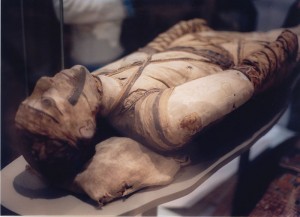By Helen King
 Have you seen the Egyptian mummies in the British Museum? Even if you’ve never been to London, you may have caught the travelling exhibition, ‘Mummy: The Inside Story’, which focuses on the priest Nesperennub, and has so far been seen by nearly 2 million people. Mummies are endlessly fascinating. They give nightmares to generations of schoolchildren who go to the British Museum on organised trips, and go home worrying about having hooks poked up their noses to get their brains out. The remain a staple of horror movies for those who left school a long time ago. CT scanning has given them a whole new lease of – er – life, enabling us to find out not only what caused their deaths, but how they lived.
Have you seen the Egyptian mummies in the British Museum? Even if you’ve never been to London, you may have caught the travelling exhibition, ‘Mummy: The Inside Story’, which focuses on the priest Nesperennub, and has so far been seen by nearly 2 million people. Mummies are endlessly fascinating. They give nightmares to generations of schoolchildren who go to the British Museum on organised trips, and go home worrying about having hooks poked up their noses to get their brains out. The remain a staple of horror movies for those who left school a long time ago. CT scanning has given them a whole new lease of – er – life, enabling us to find out not only what caused their deaths, but how they lived.
I was recently re-reading the eighteenth-century author Philip Thicknesse”s attack on man-midwifery; the claim by men that they could deliver babies more efficiently than women midwives ever could. Thicknesse, known as ‘Dr Viper’ from his sharp tongue, is probably the author of a 1764 book, Man-midwifery Analysed. In it, he takes up the comments of William Smellie – enthusiastic and innovative man-midwife, and teacher of other men-midwives – that in the primitive past, men were not midwives, and this was somehow a Bad Thing. Smellie wrote ‘It is natural to suppose, that, while the simplicity of the early ages remained, women would have recourse to none but persons of their own sex in diseases peculiar to it; accordingly, we find that in Egypt midwifery was practised by women’. What Smellie was suggesting was that early societies had ridiculous ideas of modesty that, fortunately, have ‘now’ been replaced by a modern and rational approach. In his lectures given in the 1740s, he always stressed to his students the ‘barbarism’ of the ancient world – with the possible exception of his hero, Hippocrates.
Thicknesse took issue with this denigration of the Egyptian, and other ancient, past. He said that there can’t have been much wrong with Egyptian medicine – after all, they ‘knew how to preserve dead bodies for three thousand years, so as to keep their living form’. In Egypt, he suggested, the lack of all the instruments of the ‘modern’ man-midwife – ‘hooks and crotchets, pincers, boring scissors, tapes and filleting’ – should be seen as a blessing, not a curse.
And then he writes, tongue firmly in cheek: ‘I suppose all the Egyptian mummies brought over here, besides those which are in the Museum, to be the bodies of poor Egyptian ladies, who died in child-bed; and that the hieroglyphics on their sycamore coffins, could they be deciphered, would appear to be, the lamentations of their surviving husbands, that no art could be discovered whereby nature might be corrected, and made more perfect’. Here, in addition to an attack on Smellie’s suggestion that there must have been a high death rate in childbirth if there were no men-midwives to help, we get a sense of the earliest mummy craze. The very first mummies in the British Museum were only acquired in 1756, when they were bequeathed to the collection by William Lethieullier, who had travelled to Egypt in the early 1720s.
And only in the 1820s, over twenty years after the discovery of the Rosetta Stone, were those hieroglyphs finally deciphered.
Reading:
On Smellie, Thicknesse and man-midwifery: Helen King, Midwifery, Obstetrics and the Rise of Gynaecology (2007)
On collecting: Kim Sloan, Enlightenment. Discovering the World in the Eighteenth Century (2003)
– and if you want to know about real women who were mummified, click here, and if you want to know about the hazards of telling if a mummy is male or female, click here!
